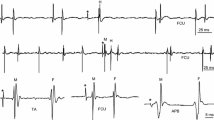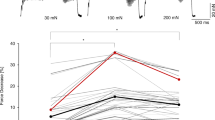Abstract
In the context of an analysis concerning factors of importance for the relative contributions of recruitment and rate gradation of muscle force, the distribution of electrical excitability was analyzed for medial gastrocnemius (MG) motoneurones of rat and cat. The experimental data came from previously collected intracellular measurements in animals anaesthetized with pentobarbitone. Electrical excitability was measured as the threshold (nanoamperes) for single spike generation (rheobase) in rat and for maintained repetitive firing (rhythmic threshold) in cat. Furthermore, the data included measurements of axonal conduction velocity and of contractile properties of the muscle units innervated by the studied motoneurones. The units were categorized into types S (slow-twitch, fatigue-resistant), FR (fast-twitch, fatigue-resistant) and FF (fast-twitch, fatiguable) on the basis of the combined criteria of twitch-speed and sensitivity to fatigue. We confirmed that, in spite of the presence of normal-looking symmetrical distributions of axonal conduction velocity, there was a positive skew in the distribution of electrical excitability (relatively high numbers of cells with low thresholds, few with high ones). Within each unit category (S, FR, FF), we ranked the motoneurones according to their relative electrical excitability and calculated the threshold difference between consecutive cells (“threshold spacing”). In accordance with the skewed distribution of electrical excitability, we found that the mean threshold spacing was ranked in the same way as the mean thresholds, i.e. S<FR<FF; the statistical analysis showed that, for cats as well as rats, small threshold-spacing steps were significantly more common for S than for FF motoneurones. In the discussion it is pointed out that the narrow threshold-spacing for S units, as compared to FF units, would tend to decrease the relative amount of recruitment-parallel rate modulation in these cells. Thus, the spacing of recruitment thresholds tends to allow the easily recruited S motoneurones to remain firing at relatively low rates during ongoing recruitment gradation, which would be of potential value in promoting a high degree of endurance for long-lasting postural contractions.
Similar content being viewed by others
References
Bakels R, Kernell D (1993) Matching between motoneurone and muscle unit properties in rat medial gastrocnemius. J Physiol (Lond) 463:307–324
Botterman BR, Iwamoto GA, Gonyea WJ (1985) Classification of motor units in flexor carpi radialis muscle of the cat. J Neurophysiol 54:676–690
Boyd IA, Davey MR (1968) Composition of peripheral nerves. Livingstone, Edinburgh
Burke RE (1981) Motor units: anatomy, physiology, and functional organization. In: Brooks VB (ed) Motor control (Handbook of physiology, Sect 1, The nervous system, vol II, part 1) American Physiological Society Bethesda, MD, pp 345–422
Burke RE, Levine DN, Tsairis P, Zajac FE (1973) Physiological types and histochemical profiles in motor units of the cat gastrocnemius. J Physiol (Lond) 234:723–748
Cooper S, Eccles JC (1930) The isometric responses of mammalian muscles. J Physiol 69:377–385
Crill WE, Schwindt PC (1984) Ionic mechanisms underlying the excitation-to-frequency transduction: studies by voltage clamp methods. Arch Ital Biol 122:31–41
Cullheim S (1978) Relations between cell body size, axon diameter and axon conduction velocity of cat sciatic alpha-motoneurons stained with horseradish peroxidase. Neurosci Lett 8:17–20
Fleshman JW, Munson JB, Sypert GW, Friedman WA (1981) Rheobase, input resistance and motor-unit type in medial gastrocnemius motoneurons in the cat. J Neurophysiol 46:1326–1338
Fleshman JW, Segev I, Burke RE (1988) Electrotonic architecture of type-identified α-motoneurons in the cat spinal cord. J Neurophysiol 60:60–85
Gardiner PF (1993) Physiological properties of motoneurons innervating different muscle unit types in rat gastrocnemius. J Neurophysiol 69:1160–1170
Gustafsson B, Pinter MJ (1985) On factors determining orderly recruitment of motor units: a role for intrinsic properties. Trends Neurosci 8:431–433
Heckman CJ, Binder MD (1991) Computer simulation of the steady-state input-output function of the cat medial gastrocnemius motoneuron pool. J Neurophysiol 65:952–967
Heckman CJ, Binder MD (1993) Computer simulations of motoneuron firing rate modulation. J Neurophysiol 69:1005–1008
Henneman E, Mendell LM (1981) Functional organization motoneuron pool and its inputs. In: Brooks VB (ed) Motor control. (Handbook of physiology, sect 1, The nervous system, vol II, part 1) American Physiological Society Bethesda, MD, pp 423–507
Henneman E, Somjen G, Carpenter DO (1965) Functional signifycance of cell size in spinal motoneurons. J Neurophysiol 28:560–580
Kernell D (1966) Input resistance, electrical excitability, and size of ventral horn cells in cat spinal cord. Science 152:1637–1640
Kernell D (1979) Rhythmic properties or motoneurones innervating muscle fibres of different speed in m. gastrocnemius medialis of the cat. Brain Res 160:159–162
Kernell D (1984) The meaning of discharge rate: excitation-to-frequency transduction as studied in spinal motoneurones. Arch Ital Biol 122:5–15
Kernell D (1992) Organized variability in the neuromuscular system: a survey of task-related adaptations. Arch Ital Biol 130:19–66
Kernell D (1993) Neuromuscular fatigue and the differentiation of motoneurone and muscle unit properties. In: Sargeant AJ, Kernell D (eds) Neuromuscular fatigue. Netherlands Academy of Arts and Sciences, North-Holland, Amsterdam, pp 139–146
Kernell D, Hultborn H (1990) Synaptic effects on recruitment gain: a mechanism of importance for the input-output relations of motoneurone pools? Brain Res 507:176–179
Kernell D, Monster AW (1981) Threshold current for repetitive impulse firing in motoneurones innervating muscle fibres of different fatigue sensitivity in the cat. Brain Res 229:193–196
Kernell D, Monster AW (1982) Motoneurone properties and motor fatigue. An intracellular study of gastrocnemius motoneurones of the cat. Exp Brain Res 46:197–204
Kernell D, Zwaagstra B (1981) Input conductance, axonal conduction velocity and cell size among hindlimb motoneurones of the cat. Brain Res 204:311–326
Kernell D, Zwaagstra B (1989) Dendrites of cat's spinal motoneurones: relationship between stem diameter and predicted input conductance. J Physiol (Lond) 413:255–269
Kernell D, Eerbeek O, Verhey BA (1983) Relation between isometric force and stimulus rate in cat's hindlimb motor units of different twitch contraction times. Exp Brain Res 50:220–227
McDonagh JC, Binder MD, Reinking RM, Stuart DG (1980) Tetrapartite classification of motor units of cat tibialis posterior. J Neurophysiol 44:696–712
Powers RK, Binder MD (1985) Distribution of ogligosynaptic input to the cat medial gastrocnemius motoneuron pool. J Neurophysiol 53:497–517
Wuerker RB, McPhedran AM, Henneman E (1965) Properties of motor units in a heterogeneous pale muscle (m. gastrocnemius) of the cat. J Neurophysiol 28:85–99
Author information
Authors and Affiliations
Rights and permissions
About this article
Cite this article
Bakels, R., Kernell, D. Threshold-spacing in motoneurone pools of rat and cat: possible relevance for manner of force gradation. Exp Brain Res 102, 69–74 (1994). https://doi.org/10.1007/BF00232439
Received:
Accepted:
Issue Date:
DOI: https://doi.org/10.1007/BF00232439




